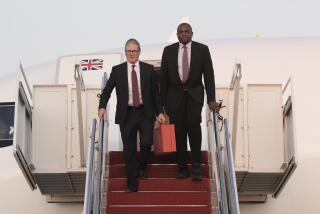U.S. to Tell Russia How Many Warheads Could Go
- Share via
WASHINGTON — After weeks of heated internal wrangling, the Bush administration today intends to give Russia the outline of its plan for reducing U.S. offensive nuclear weapons, potentially opening the way for a breakthrough on its missile defense plan, according to administration officials.
The deal could eliminate the possibility that the United States would abrogate the 1972 Antiballistic Missile Treaty, the cornerstone of international arms control treaties, according to U.S. and Russian sources.
A compromise now under consideration would allow the United States to engage in more robust testing for a new missile defense shield within mutually agreed-upon parameters. In exchange, Washington would not back out of the ABM treaty, as it has threatened to do.
The deal, which would in effect modify the ABM treaty, could be formalized through a joint statement or a new protocol, the sources said.
It would also include broader agreements on Russia’s relationship with NATO, its proposed membership in the World Trade Organization, the rescheduling of its foreign debt, cooperation on intelligence matters and other issues--bundled in the framework of a new partnership between the onetime enemies, according to U.S. and Russian officials.
The goal is to have an outline developed on each issue before the Nov. 13-15 summit in the United States between President Bush and Russian President Vladimir V. Putin.
“Russia is not asking for a voice in what testing would be allowed. It accepts that the U.S. would do what it wants to do. What Russia wants most out of any agreement is a new relationship that positions it as America’s junior partner. If that happens, all other elements will fall into place,” said Dimitri K. Simes, president of the Nixon Center, a foreign policy study center that is co-hosting a major speech by Putin in Washington on Nov. 13.
“This kind of deal would be a victory for both sides. Both could come away claiming victory,” said Joseph Cirincione, director of the nonproliferation project at the Carnegie Endowment for International Peace, a public policy center in Washington.
The first step in this process is for the United States to provide Russia with the number of nuclear warheads it proposes to cut.
The Bush administration has tried to win support for its missile defense proposal by devising a new strategy involving both offensive and defensive weapons. Sharply reducing the number of offensive nuclear weapons from the current figure of about 7,000 is the selling point for creating a new defensive system, U.S. officials have argued.
But debate has been intense within the administration over how exposed the United States might be after making significant reductions. The military and political wings of the Pentagon were still settling their own differences Wednesday, the sources added.
The administration intends to have Secretary of State Colin L. Powell outline the plan to Russian Foreign Minister Igor S. Ivanov at talks being held here today to plan for the summit.
Secretary of Defense Donald H. Rumsfeld is scheduled to fly to Moscow on Friday to discuss the U.S. offer with Russian defense officials, in addition to discussing the U.S. military campaign in Afghanistan.
The debate between Pentagon hawks and Bush administration political appointees over the fundamental shift in U.S. defense strategy has been so fractious that Bush was unable to outline his proposed cuts to Putin, as originally planned, during their meeting in Shanghai last month.
Adm. Richard W. Mies, commander of the U.S. Strategic Command, which oversees the strategic nuclear arsenal, leads the field of those who argue vehemently that the current arsenal is needed to assure stability and guarantee that U.S. forces could respond even after a nuclear attack.
“There is a tyranny in very deep numerical reductions that inhibits flexibility and induces instability in certain situations,” Mies told the Senate Armed Services Committee on July 11.
The military “drew a line in the sand” about reductions, Cirincione said Wednesday. Mies and others have stuck with the traditional Cold War doctrine that the United States needs land-, sea- and air-based nuclear forces able to withstand an adversary’s first strike and still respond. They have argued that Washington could not go below 2,300 to 2,500 warheads, while the Bush administration has called for cuts down to at least 2,000.
“The military always feels better with more. It gives them more flexibility,” said an administration official who has argued for larger cuts. “But they also have to face budget restraints and diverse threats to balance. And we don’t need to spend billions maintaining a nuclear arsenal if the threats are now coming from elsewhere.”
Rather than come up with a specific number of warheads, the administration is talking about a range, possibly from 1,500 to 2,000, according to sources familiar with the internal debate.
During the presidential campaign last year, Bush argued that the two countries’ nuclear arsenals--more than 30,000 warheads at the peak of the Cold War--could be greatly reduced. The Russians have been pushing for a joint agreement that would lower the target for each country’s nuclear arsenal to about 1,500 deployed warheads.
The United States currently has about 7,000 deployed warheads and Russia about 6,000. But because of tight budgets and maintenance difficulties, Russia’s functioning arsenal is expected to decline sharply, to as few as 1,000, in the years ahead, according to the Carnegie Endowment for International Peace.
*
Times staff writer Paul Richter contributed to this report.
More to Read
Get the L.A. Times Politics newsletter
Deeply reported insights into legislation, politics and policy from Sacramento, Washington and beyond. In your inbox twice per week.
You may occasionally receive promotional content from the Los Angeles Times.










